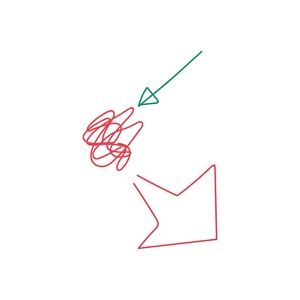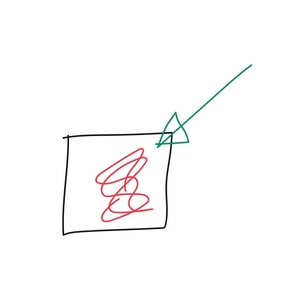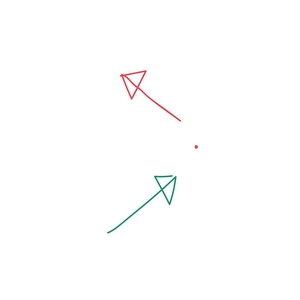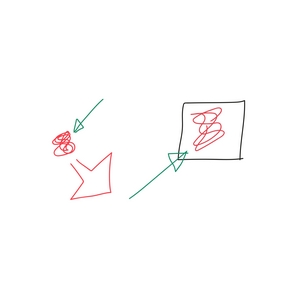Blog #19
In general, individuals who have not finished responding (see unfinished business) to an earlier threat in life are left with baggage in their nervous system. This either speeds them up or slows them down, leading to them over- or under-reacting to new stimuli in life, which we sometimes call triggers if they lead to one of these out-of-scale reactions. Sometimes, however, we get it just right, and so we have three basic ways of reacting to a stimulus, or trigger. We can draw these three different ways of reacting as three different diagrams like below. The red squiggle represents your baggage, the green arrow is a trigger, and the red arrow is your output, or reaction.
Overreaction:

Under-reaction: (In this diagram, the box represents little to no reaction, where the energy is instead internalised.)

Just right, or Goldilocks reaction:

If we go with the idea that any one person can be represented by any one of these diagrams, then we can begin to build a picture of the kinds of relationships we have in life. These can be romantic relationships, or any type of relationship; family, friends, colleagues. We sometimes find that the dynamics discussed here are most noticeable or extreme in romantic relationships, so that’s a good focus to illustrate the points, but the analysis works for everyone.
If you have three kinds of people, then you can have six kinds of relationships.
Over-reaction with an under-reaction
I want you to imagine the people represented in the diagram above standing next to each other. On this example we are going to take one over-reacting person and place them next to an under-reacting person. Then I want you to imagine that you are going to turn them into an animated cartoon. What happens to those arrows? How would the cartoon develop over time? What would get bigger and what would get smaller?

When I look at this, I get worried. This is a recipe for the person in the black box to become overwhelmed by the over-reactions of the other person, but without this causing any energised response with which to either protect themselves or to get away. This is the profile of an abusive relationship in which the abused person doesn’t leave. The lack of reaction from the under-reaction means that there is nothing to push back at the over-reactions of the other person.
The next stage in your imaginary animation is for you to allow both of these people to move left to right on the page. Which direction do you think they would both like to go in? I see the under-reaction person as very inert, and therefore unlikely to move far, or indeed fast. They may move away from the relationship slowly, or occasionally, but the energy of the over-reacting person will catch up with them. So I see the black box trying to drive away but being held in place by the size of the other’s red arrow.
This can go on over a long period of time. Neither party is really able to help themselves or the other because there is no balance. Sometimes people in a relationship like this think that the other compensates for their missing attributes, like fire and ice, but in reality, this is not a relationship in which it is easy for either side to grow. One party is out of control and the other is super controlled. Each needs to find a way to be more in the middle of the reaction spectrum and although the other compensates for them, they don’t model how to do it right either. So, it usually doesn’t work, and most of the time people get hurt instead until something, somewhere breaks.
Does this remind you of anyone?
There is a lot of talk these days about abusive relationships. It can be uncomfortable. There is often a sense, especially looking back on a relationship, that there was an abuser and someone abused. Usually we never identify ourselves as the abuser! This can be a valid way to describe the situation from a social point of view, but the story from the nervous system perspective is a bit more nuanced.
People who over-react are drawn towards people who under-react because they can survive themselves (their own nervous systems) with no consequences. This allows them actually to have relationships which can last a while, which usually is what most people want. They are somewhat handicapped by their over-reacting nervous system and, like all of us, find adaptive ways to try to get what everyone wants in life, even with that difficulty.
Under-reacting people, by contrast, often find life very flat and dull. Their inner landscape is barren, so when they first encounter someone who is somewhat out of control, this feels like being around someone who brings them to life. Again, this is a valid adaptation. In this case this person is really trying to come to life to have a relationship with themselves. Unfortunately, it has consequences.
Most of these relationships would not hit the headlines. They are not violent, or criminal, or even obviously unpleasant. But they are not healthy, and these nervous systems are going nowhere. At their extreme though, they can be the kinds of abuse we do hear about in the news, and that is why it is worth identifying them even when they are not too bad, so that they don’t get any worse.
Each party can do the other a favour by learning how to manage their reactions, or lack of them, more skilfully. Our style of communication can make a big difference in making these relationships work towards a balance of both positions for each person, rather than an attempt just to cancel out each other’s extremes.

You can download this post in a handy 2-page PDF to print and share with friends, family, clients or colleagues. Follow this link to download now.
You can buy a copy of The Invisible Lion now on kindle or paperback from your local Amazon store. Just click here to buy now.


